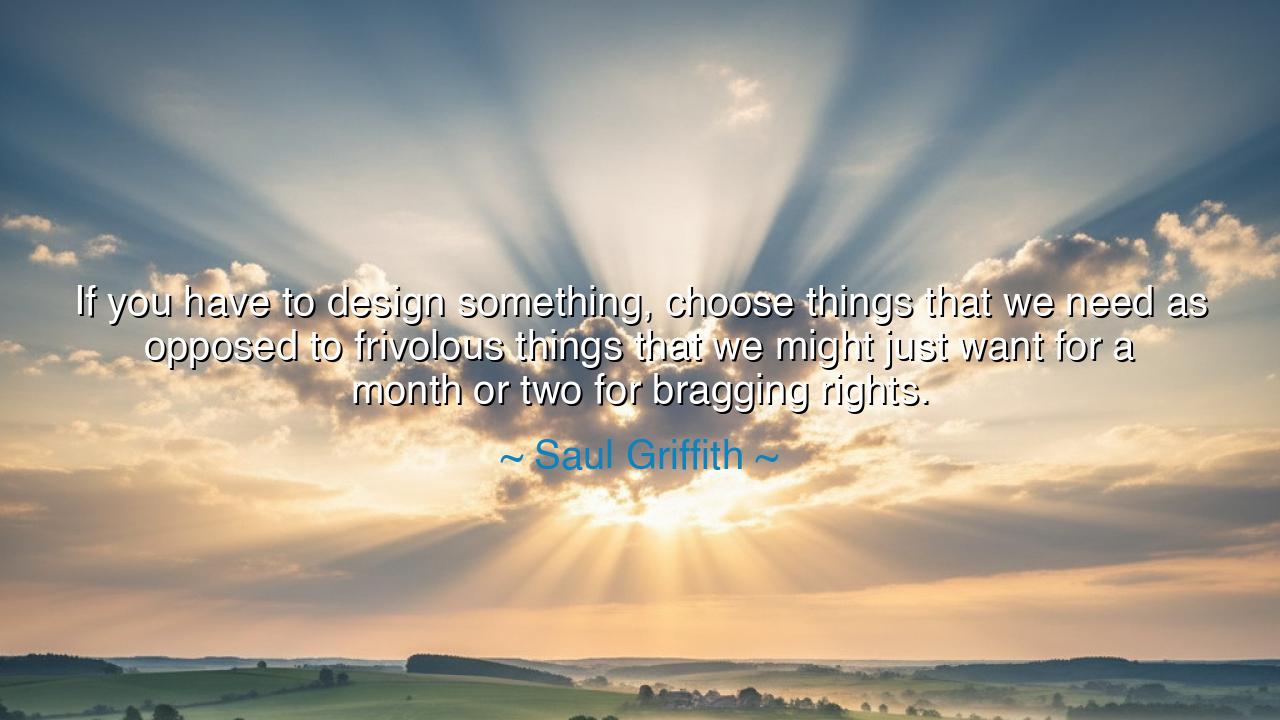
If you have to design something, choose things that we need as
If you have to design something, choose things that we need as opposed to frivolous things that we might just want for a month or two for bragging rights.






“If you have to design something, choose things that we need as opposed to frivolous things that we might just want for a month or two for bragging rights.” – Saul Griffith
Listen, O makers of the future and shapers of the material world, to the words of Saul Griffith, inventor and visionary, who stands among those who build not for vanity but for necessity. His wisdom resounds like an ancient call to the craftsman’s conscience: “If you have to design something, choose things that we need, not frivolous things we might just want for a month or two for bragging rights.” In these words lies not only the discipline of engineering, but the ethic of creation itself—the reminder that invention is not merely about skill, but about purpose.
Griffith, who has labored in the fields of sustainable energy and human-centered design, speaks from the heart of experience. He has seen how the age of innovation has often lost its direction—how the craft of design, once guided by necessity, has become ensnared in desire and vanity. The world overflows with objects: glowing screens, glittering gadgets, fleeting trends. Yet how few of these creations nourish life, ease suffering, or heal the Earth? His words are a plea for restoration—for returning to that sacred alignment between human need and human creativity.
For in the beginning, all design was born from necessity. The wheel was not made to boast, but to move; the plow not to dazzle, but to feed. The ancients who built the aqueducts of Rome or the rice terraces of China did so not for applause, but to sustain their people and their land. And even the artists and architects of old—Michelangelo, Da Vinci, Brunelleschi—though masters of beauty, sought always to wed elegance with function. Beauty was never empty; it was the servant of truth and purpose. Frivolity was alien to their art, for to create was to serve both body and soul.
Yet, as Griffith observes, in our modern age the heart of design has been tempted by pride. The designer, once a healer of the world’s wounds, is too often turned into a merchant of novelty. Countless minds and materials are spent creating objects meant not to endure, but to be discarded once the thrill fades. We chase the new not because we need it, but because we fear being forgotten without it. Such “bragging rights”, as Griffith calls them, are the modern idol—an altar on which we sacrifice time, talent, and even the Earth itself.
Consider the story of Isambard Kingdom Brunel, the 19th-century engineer whose designs changed the face of Britain. He built bridges, tunnels, and ships—not to enrich himself, but to connect people, to expand the reach of civilization. His work was bold and beautiful, but every rivet served a human purpose. His ambition was not vanity, but service. Contrast this with the fleeting marvels of our day—devices obsolete in a season, products designed to break rather than last. Brunel built for centuries; we too often build for months. Griffith’s words remind us that progress without purpose is not progress, but distraction.
This wisdom extends beyond the workshop or laboratory—it touches the very core of how we live. To choose what we need over what we want is an act of maturity, a discipline of spirit. The same principle that guides a responsible designer should guide every human being: to invest our time, our energy, and our talents in what endures. Let our creations—whether they be objects, relationships, or legacies—bring sustenance, not spectacle; meaning, not momentary pleasure.
So, O children of invention, take this counsel to heart: Design for necessity, not for noise. Create what uplifts humanity, not what flatters the ego. Let your work serve life itself—its continuity, its dignity, its beauty. Every invention carries the power to heal or to harm; every design is a choice between service and self. Choose, then, as Griffith commands, the path of responsibility, for it leads not only to usefulness, but to honor.
And thus, remember: the true designer is not the one who astonishes the crowd, but the one who betters the world. To build what is needed is to align your hands with the rhythm of creation itself. For when you create not for bragging rights, but for the betterment of humankind, your work becomes eternal—not in fame, but in its quiet, lasting grace.






AAdministratorAdministrator
Welcome, honored guests. Please leave a comment, we will respond soon